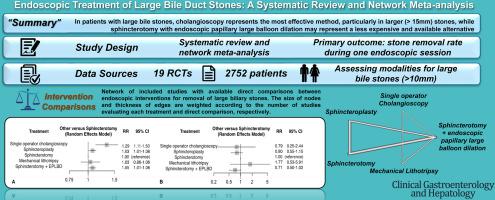Clinical Gastroenterology and Hepatology ( IF 11.6 ) Pub Date : 2021-10-16 , DOI: 10.1016/j.cgh.2021.10.013 Antonio Facciorusso 1 , Paraskevas Gkolfakis 2 , Daryl Ramai 3 , Georgios Tziatzios 4 , Janice Lester 5 , Stefano Francesco Crinò 6 , Leonardo Frazzoni 7 , Ioannis S Papanikolaou 4 , Marianna Arvanitakis 2 , Daniel Blero 2 , Arnaud Lemmers 2 , Pierre Eisendrath 2 , Lorenzo Fuccio 7 , Konstantinos Triantafyllou 4 , Armando Gabbrielli 6 , Jacques Devière 2

|
Background & Aims
Several endoscopic methods have been proposed for the treatment of large biliary stones. We assessed the comparative efficacy of these treatments through a network meta-analysis.
Methods
Nineteen randomized controlled trials (2752 patients) comparing different treatments for management of large bile stones (>10 mm) (endoscopic sphincterotomy, balloon sphincteroplasty, sphincterotomy followed by endoscopic papillary large balloon dilation [S+EPLBD], mechanical lithotripsy, single-operator cholangioscopy [SOC]) with each other were identified. Study outcomes were the success rate of stone removal and the incidence of adverse events. We performed pairwise and network meta-analysis for all treatments, and used Grading of Recommendations, Assessment, Development, and Evaluation criteria to appraise the quality of evidence.
Results
All treatments except mechanical lithotripsy significantly outperformed sphincterotomy in terms of stone removal rate (risk ratio [RR], 1.03–1.29). SOC was superior to other adjunctive interventions (vs balloon sphincteroplasty [RR, 1.24; 95% CIs, 1.07–1.45], vs S+EPLBD [RR, 1.23; range, 1.06–1.42] and vs mechanical lithotripsy [RR, 1.34; range, 1.14–1.58]). Cholangioscopy ranked the highest in increasing the success rate of stone removal (surface under the cumulative ranking [SUCRA] score, 0.99) followed by S+EPLBD (SUCRA score, 0.68). SOC and S+EPLBD outperformed the other modalities when only studies reporting on stones greater than 15 mm were taken into consideration (SUCRA scores, 0.97 and 0.71, respectively). None of the assessed interventions was significantly different in terms of adverse event rate compared with endoscopic sphincterotomy or with other treatments. Post-ERCP pancreatitis and bleeding were the most frequent adverse events.
Conclusions
Among patients with large bile stones, cholangioscopy represents the most effective method, in particular in patients with larger (>15 mm) stones, whereas S+EPLBD could represent a less expensive and more widely available alternative.
中文翻译:

大胆管结石的内镜治疗:系统评价和网络荟萃分析
背景与目标
已经提出了几种内窥镜方法来治疗大的胆管结石。我们通过网络荟萃分析评估了这些治疗的比较疗效。
方法
19 项随机对照试验(2752 名患者)比较了治疗大胆结石(>10 毫米)的不同治疗方法(内窥镜括约肌切开术、球囊括约肌成形术、括约肌切开术继以内窥镜乳头状大球囊扩张 [S+EPLBD]、机械碎石术、单人胆管镜检查[SOC]) 彼此进行了鉴定。研究结果是结石清除的成功率和不良事件的发生率。我们对所有治疗进行了成对和网络荟萃分析,并使用推荐分级、评估、开发和评估标准来评估证据的质量。
结果
除机械碎石术外,所有治疗在结石清除率方面均显着优于括约肌切开术(风险比 [RR],1.03–1.29)。SOC 优于其他辅助干预措施(对比球囊括约肌成形术 [RR,1.24;95% CI,1.07–1.45],对比 S+EPLBD [RR,1.23;范围,1.06–1.42] 和机械碎石术 [RR,1.34;范围, 1.14–1.58])。胆管镜在提高取石成功率方面排名最高(表面累积排名 [SUCRA] 得分为 0.99),其次是 S+EPLBD(SUCRA 得分为 0.68)。当仅考虑报告结石大于 15 毫米的研究时,SOC 和 S+EPLBD 优于其他方式(SUCRA 评分分别为 0.97 和 0.71)。与内窥镜括约肌切开术或其他治疗相比,所评估的干预措施在不良事件发生率方面均无显着差异。ERCP 术后胰腺炎和出血是最常见的不良事件。
结论
在胆结石较大的患者中,胆管镜检查是最有效的方法,尤其是对于结石较大 (>15 mm) 的患者,而 S+EPLBD 可能是一种更便宜且应用更广泛的替代方法。











































 京公网安备 11010802027423号
京公网安备 11010802027423号